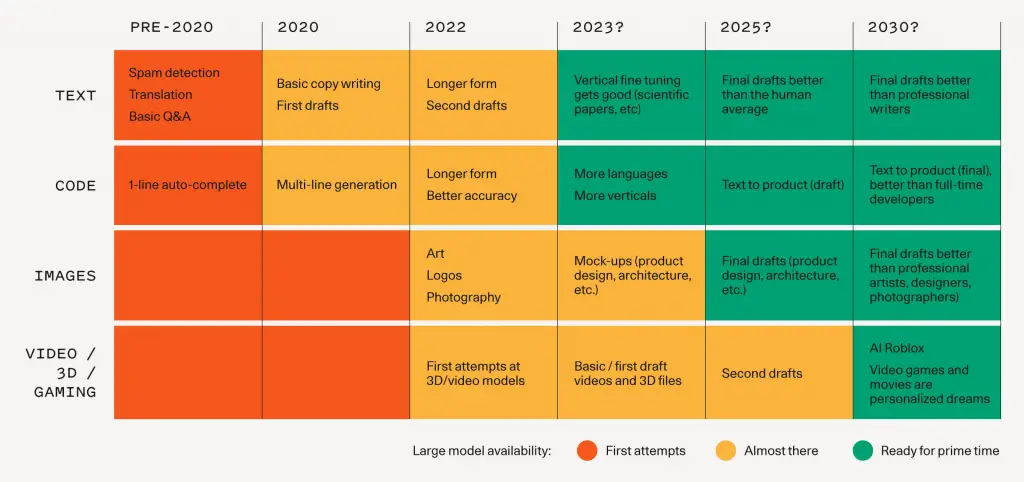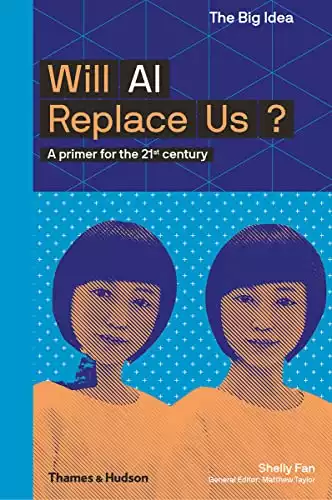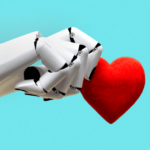Introduction
In an era of rapid technological evolution, one question persistently lingers – ‘When and how will your work be replaced by AI?’. This exploration delves into the implications of artificial intelligence for various sectors, from the most mundane to the highly specialized tasks. It seeks to demystify AI’s transformative power, offering a nuanced perspective on the intersection of AI and the workplace.
Whether your role is in healthcare, finance, arts, or any other sector, this insightful discussion provides an understanding of the timeline and methodology behind AI’s potential to reshape your work landscape. Prepare to challenge your assumptions, stimulate your curiosity, and uncover new possibilities in the face of AI-driven change.
Also Read: Will AI Replace My Job?
Table of Contents

The Year 2022
Text
In the category of text, artificial intelligence was poised to usher in substantial changes, primarily in long-form content generation. Leveraging sophisticated language models, AI had the capability to produce contextually coherent and grammatically sound content that could mimic human writing styles. From drafting comprehensive reports to scripting engaging articles, AI’s ability to generate meaningful and consistent narratives had become an industry standard, potentially revolutionizing fields like journalism, marketing, content creation, and more.
Code
When it comes to coding, the precision and efficiency offered by AI cannot be understated. Advanced AI models can aid in writing longer, complex code with remarkable accuracy. The technology can automate repetitive coding tasks, identify errors, suggest corrections, and even generate entire code snippets based on specific requirements. The integration of AI in this field can dramatically speed up the coding process, reduce errors, and elevate the quality of the code, profoundly impacting the software development lifecycle.
Images
The category of imagery, encompassing art, logos, and photography, is not immune to AI’s influence either. Innovative applications of AI, such as Generative Adversarial Networks (GANs), are already creating unprecedented possibilities. AI can assist in designing intricate logos, generating original art, enhancing photography, and even creating hyper-realistic images from scratch. As AI technologies continue to evolve, we can expect a significant transformation in the creative design and photography sectors.
Video / 3D Models
Venturing into the sphere of video production and 3D modeling, we are witnessing the preliminary applications of AI. AI is being utilized to automate video editing, improve video quality, generate realistic 3D models, and even create brief video clips. The integration of AI can streamline the video production process and bring a new level of sophistication to 3D modeling. Despite being in the early stages, the potential impact of AI in this space is immense and will continue to grow as the technology matures.
Also Read: Redefining Art with Generative AI
The Year 2023 – We are here now
Text
Currently, artificial intelligence has developed to such an extent that it is proficient in writing on complex subjects. Capable of generating comprehensive scientific papers, AI is capable of composing well-structured, logically coherent articles complete with references. Using natural language processing and machine learning algorithms, AI can create content that mirrors human writing in quality and style. From drafting abstracts to writing full-length papers, AI’s role in scientific research and academic writing is rapidly expanding.
Code
AI has become a versatile tool in the realm of coding, able to write code in multiple languages, thanks to advancements in large language models (LLMs) and generative AI. It can generate complete blocks of code, correct errors, and even provide optimizations. With the ability to comprehend and write in a multitude of programming languages, AI has become an invaluable tool for programmers, reducing the time and effort involved in coding and enhancing the overall efficiency of the development process.
Images
In the field of visual design, AI is making significant strides. It’s capable of generating high-quality mockups, providing nearly finalized touches to product design and architecture. AI has become adept at understanding design briefs, creating design elements, and combining them to produce comprehensive mockups. From logos to product prototypes to architectural plans, AI’s contributions are improving the speed, efficiency, and creative possibilities in design-related fields.
Video / 3D Models
Artificial intelligence has also extended its capabilities to the video and 3D modeling domains. It’s now capable of generating basic 3D models and videos, making use of deep learning techniques to understand and replicate visual details. AI can automate the video editing process, create simple animations, and even build basic 3D models. Although this technology is still in its early stages, the potential for creating more complex 3D models and videos is significant and continues to grow.
The Year 2025
Text
In the future, the quality of text drafts generated by AI will surpass those written by humans. AI will integrate elements of critical thinking throughout the text, drawing upon vast databases of information to form cohesive, sophisticated arguments. As AI’s learning algorithms become more refined and complex, we can expect to see AI-written text become indistinguishable from, or perhaps superior to, human writing.
Code
With advancements in technology, the generation of production-level code from generic text will become feasible and widely used. AI will possess the capability to understand high-level descriptions and generate intricate, functioning code based on them. This will significantly streamline the software development process, making it faster and more efficient.
Images
In the domain of visual design, AI will generate near-final mockups that are ready for production in fields like product design and architecture. AI will refine its abilities to interpret briefs accurately, predict design trends, and generate high-quality designs. The final touches made by human designers will become minimal, as AI will be able to create production-ready designs.
Video / 3D Models
We can expect AI to generate improved versions of videos and 3D models. AI will enhance its abilities to analyze visual data, understand structural concepts, and create sophisticated animations and 3D models. As AI’s learning algorithms become more sophisticated, the quality and complexity of AI-generated videos and 3D models will continue to increase.
The Year 2030
Text
Generative AI will be crafting texts that surpass human capacity, even on multifaceted topics. The system’s proficiency in understanding and synthesizing vast amounts of information will lead to the creation of comprehensive, nuanced, and highly accurate pieces. This transformative innovation will greatly impact areas such as content creation, academic research, and technical documentation.
Code
Generative AI is predicted to revolutionize the field of programming by producing software programs that outperform those written by human developers. The potential of AI to process information at an unparalleled speed, combined with the ability to learn from vast datasets, will result in efficient, sophisticated, and error-free code generation. This will be a game-changer in software development, resulting in accelerated timelines and enhanced code quality.
Images
AI’s role in design and visualization will escalate to new heights in the future. The technology will be generating mockups, presentations, and designs that exceed human capability. Not only will it streamline the creation process, but it will also incorporate levels of critical thinking and innovative concepts beyond human capacity. This will lead to a new era of design where AI shapes the aesthetics, usability, and effectiveness of visuals.
Video / 3D Models
The production of high-quality movies and 3D models will be revolutionized by AI. It will be capable of generating hyper-personalized videos and 3D models tailored to specific audiences or individuals. From creating engaging narratives in films to constructing detailed and accurate 3D models, AI will significantly enhance the quality and personalization of visual content. This will open up new avenues for interactive media, marketing, education, and entertainment.
Challenges With Rapid Progression of Generative AI
The rapid progression of generative AI presents several challenges that are critical to consider as we approach the foreseeable future. As more users start uploading their personal images, videos, and voices on various platforms, scams and fraud will become increasingly personalized. This trend could potentially transform the landscape of cybercrime, making it even more difficult to detect and counteract. The use of personal data to fuel generative AI tools could lead to increased instances of identity theft, deepfake scams, and other forms of digital deceit, which surpasses the capabilities of their human counterparts in terms of sophistication and personalization.
In addition to security concerns, the ethical implications of generative AI cannot be overlooked. As AI starts to perform tasks previously accomplished by human workers, questions about fairness, job displacement, and the future of the job market arise. For example, as AI begins to automate repetitive tasks, positions like office workers, market research analysts, and supply chain workers may become obsolete. While AI may enhance efficiency and productivity, it could also create a significant displacement in the labor market, affecting livelihoods and economic stability.
In response to these ethical implications, it is vital for humans to form ethical committees dedicated to establishing frameworks and guidelines for AI operation. These committees would oversee the design, development, and deployment of AI, ensuring that its use aligns with societal norms and values. For example, guidelines could dictate that the use of autonomous robots and self-driving cars should prioritize human safety and welfare above all else.
The aspect of emotional intelligence also plays a pivotal role in this discussion. While AI may excel at cognitive tasks, it lacks the social intelligence necessary for tasks that require a human touch. For example, although AI might eventually replace a human artist in creating AI-generated content, it may struggle to replicate the emotional depth and creativity inherent in human art. Similarly, an AI could not replace a robot psychiatrist, as it lacks the ability to genuinely empathize with human emotions.
As we advance towards a future increasingly shaped by generative AI, it’s important to consider the potential repercussions. The focus should not only be on harnessing the power of AI but also on building robust frameworks to govern its use, prioritizing emotional intelligence, and preparing for the potential transformation of the job market. This comprehensive approach will help us navigate the challenges of this rapidly evolving technology while maximizing its benefits.
Also Read: Could AI Replace Humans?
Conclusion
As we move closer to 2030, the prospect of AI replacing most jobs becomes increasingly tangible, driven by advancements in AI-powered tools and machines. From the manufacturing industry to food services, the capabilities of AI have expanded to such a degree that tasks once thought uniquely human are now within the grasp of AI.
For example, the creative tasks of graphic artists, traditionally considered immune to automation due to the inherent complexity and creativity of the human brain, are now being tackled by AI. Advanced technologies have enabled AI to generate artwork, design logos, and even create complex graphic designs, disrupting the graphic design industry and potentially displacing human workers.
The manufacturing industry has long been a target for automation, but with the introduction of AI-enabled robots, the landscape is evolving more drastically. The abilities of these robots go beyond the repetitive tasks performed by traditional factory workers.
Equipped with advanced decision-making capabilities and facial recognition systems, these AI-powered machines can perform complex tasks such as quality control and equipment maintenance, significantly reducing the need for human labor. This technological shift has profound implications for manufacturing jobs, as well as the future workforce.
Beyond creative tasks and manufacturing, AI is making significant inroads in industries like law and healthcare. Legal assistants, traditionally responsible for drafting documents and performing legal research, are being outpaced by AI programs capable of analyzing vast amounts of legal data in a fraction of the time.
Similarly, AI advancements in healthcare are so robust that the concept of robotic doctors is no longer science fiction. These AI systems can analyze medical images, predict patient outcomes, and even perform routine diagnostic procedures, fundamentally reshaping the roles of human healthcare providers.
The transportation industry also stands on the brink of a significant shift, with autonomous vehicles poised to redefine the concept of driving. Self-driving cars equipped with advanced AI systems can navigate traffic, adhere to road rules, and even make complex decision-making in unpredictable situations. As these technologies become mainstream, a substantial portion of driving jobs may be phased out, further underscoring the pervasive influence of AI on various aspects of human labor.
As AI-powered tools continue to advance, business leaders must prioritize skill investment in their human workforce. While AI holds immense potential for automating business processes, it is crucial to remember that it can’t replicate the emotional intelligence and interpersonal skills innate to humans. As we navigate towards an AI-dominated future, we must also focus on developing skills that distinguish us as human, ensuring there is ethical balance in the future. For us to have that balance in the future we need to start NOW.
References
akosner. “Generative AI: A Creative New World.” Sequoia Capital, 19 Sept. 2022, http://sequoiacap.com/article/generative-ai-a-creative-new-world. Accessed 18 July 2023.
Fan, Shelly. Will AI Replace Us: A Primer for the 21st Century (The Big Idea Series). Thames & Hudson, 2019.
Lee, Kai-Fu, and Chen Qiufan. AI 2041: Ten Visions for Our Future. Currency, 2021.
West, Darrell M. The Future of Work: Robots, AI, and Automation. Brookings Institution Press, 2018.












